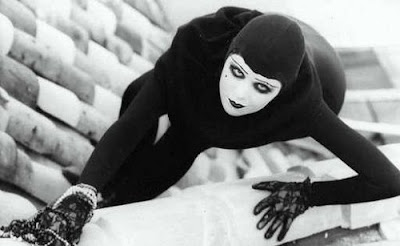What are the sartorial origins of the black-clad dominatrix? I will skip the more familiar examples from recent years and try to find the earlier examples.
Certainly everyone will remember Diana Rigg as Mrs. Emma Peel (“Miss SM Appeal”) in the UK spy TV series The Avengers. Her most overtly kinky costumes were features in the episodes “A Touch of Brimstone” and “Death at Bargain Prices.”

Diana Rigg as Emma Peel in The Avengers, wearing the leather jumpsuit costume from “Death at Bargain Prices”
A low-budget British take on The Day the Earth Stood Still, Devil Girl from Mars (1954) doesn’t have a lot to recommend it. The main appeal is Patricia Laffan as the title character in a striking costume, made of some black shiny material, possibly vinyl.
The “devil girl”, Nyah, is here to abduct men from Earth to repopulate her planet, an inversion of the usual themes from this type of film. Icy, superior, powerful, and sexually aggressive, Nyah certainly hit the dominatrix marks.
In the black and white era of film, color obviously could not be shown, but black could make a strong impression. A classic icon in American film is the black satin strapless dress worn by Rita Hayworth in Gilda (1946). In her song and dance number, the light shines sensually on her dress as she dances. Broadcasters have a saying that “radio is a visual medium”, and I’ve often thought that by extension, “film is a tactile medium”. The play of light on the black satin wrapping a woman’s body gives some impression of what it would be like to touch her.

Rita Hayworth in her iconic black satin dress in Gilda (1943)
The Gilda dress was, in turn, inspired by a notorious 1884 painting, Portrait of Madame X, by John Singer Sargent.

Portrait of Madame X, by John Singer Sargent, 1884.
One of Marlene Dietrich‘s earlier vehicles was Dishonored. Her character wore a black leather flying suit (and wore it well).

Marlene Dietrich (left) in Dishonored

For a while, I had assumed that the prototype of the dominatrix was French actress Musidora as “Irma Vep” in the French silent action serial Les Vampires. Her black full-body silk suit made her famous.
At a time when just seeing the shape of a woman’s calf in public was a novelty, Musidora’s nude-but-not-nude body must have been a sensation.

However, I learned that even before Musidora, there was another French actress famous for wearing skin-tight black on film. Josette Andriot, a sportswoman turned actress, was the star of the French silent serial Protea, beginning in 1913. Unlike Irma Vep, Protea was unambiguously a heroine, with a talent for slipping in and out of disguises. Her black body-suit was made of practical cotton, not sensuous silk. She may have been the prototype for the cinematic action heroine.

Unfortunately, the Protea series seems to be some of the many lost films of the silent era. I could only find a clip of part of the first one.
As others have noted, 1920 was around when the materials fetishized in pornography shifted from “soft media” like fur, silk and lace, to “hard media”, such as leather, rubber, and PVC.
In the 19th century, burlesque and music hall theatre were a place for fantasy and play, defying Victorian/Edwardian class and gender norms. Gender impersonators like Vesta Tilley and Malcolm Scott were popular stars. An Amazonian woman named Katie Sandwina (named after male bodybuilder and strongman Eugen Sandow) performed feats of strength. And in contrast to the ankle-length, wide dresses worn by most women, dancers and acrobats could wear tights and body stockings.

Dolly Adams with fringe at the bottom of a short costume, tights, short-heeled boots topped with fringe, cross at neck, cap. Source
The relatively unadorned female silhouette must have been a striking sight.
The other primary source of the dominatrix style was likely the riding habits of upper class women. Equestrianism was one of the few fields in which women could acceptably show athletic prowess. Women wore masculine-influenced, form-fitting costume in the darker colors usually only seen on men’s clothing.

By Constantine von Grimm – Published in Vanity Fair, 5 April 1884.
Downloaded from http://www.philaprintshop.com/images/vf4584.jpg, Public Domain, Link
It would appear that the dominatrix per se didn’t crystallize until the 1920s or 1930s.




